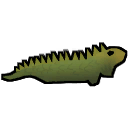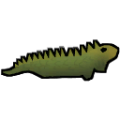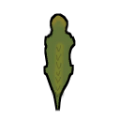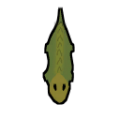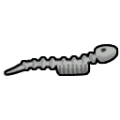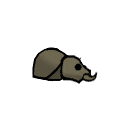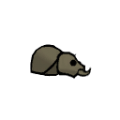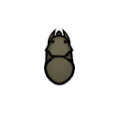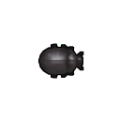Difference between revisions of "Animals"
m |
|||
| Line 28: | Line 28: | ||
<references/> | <references/> | ||
| + | |||
| + | <div class="pull-left">{{:Boomrat}}</div> | ||
| + | <div class="pull-left">{{:Iguana}}</div> | ||
| + | <div class="pull-left">{{:Megascarab}}</div> | ||
{{nav|animal}} | {{nav|animal}} | ||
[[Category:Animals]] | [[Category:Animals]] | ||
| + | [[Category:Wild]] | ||
Revision as of 00:24, 17 August 2014
In RimWorld, animals roam the world free, minding their own business, eating plants and pacing back and forth. Apart from becoming mad and attacking any people on sight, animals can also be used as a source of food through preparing meals.
Growing food outdoors can sometimes attract animals inside your base perimeter.
[[version/
|
Current version
The most current PC version in our database is: 1.5.4241
The most current console version in our database is: 1.23
Is this not correct? Please feel free to update it yourself, or let us know on the Rimworld Discord!
Past PC versions
All public versions can be found in the expanding table below. All past versions including Internal, Public, Silent, Hotfixes, Release, Alpha & Beta versions, can be found on the Category:Version page.
If there is a version that is missing, please feel free to add it! Just don't forget to tag the page with the Version Category!
Past console versions
All past console versions can be found on the Category:Console version page. This has a list of every version tagged by that category.
If there is a version that is missing, please feel free to add it! Just don't forget to tag the page with the Console version Category!
| Version | Release Date |
|---|---|
| Console version/1.23 | 12 May 2023 |
| Console version/1.22 | 4 May 2023 |
| Console version/1.21 | 25 April 2023 |
| Console version/1.11 | 8 December 2022 |
| Console version/1.10 | 29 September 2022 |
| Console version/1.09 | 21 September 2022 |
| Console version/1.08 | 25 August 2022 |
| Console version/1.07 | 10 August 2022 |
| Console version/1.06 | 4 August 2022 |
|
|
Current version
The most current PC version in our database is: 1.5.4241
The most current console version in our database is: 1.23
Is this not correct? Please feel free to update it yourself, or let us know on the Rimworld Discord!
Past PC versions
All public versions can be found in the expanding table below. All past versions including Internal, Public, Silent, Hotfixes, Release, Alpha & Beta versions, can be found on the Category:Version page.
If there is a version that is missing, please feel free to add it! Just don't forget to tag the page with the Version Category!
Past console versions
All past console versions can be found on the Category:Console version page. This has a list of every version tagged by that category.
If there is a version that is missing, please feel free to add it! Just don't forget to tag the page with the Console version Category!
| Version | Release Date |
|---|---|
| Console version/1.23 | 12 May 2023 |
| Console version/1.22 | 4 May 2023 |
| Console version/1.21 | 25 April 2023 |
| Console version/1.11 | 8 December 2022 |
| Console version/1.10 | 29 September 2022 |
| Console version/1.09 | 21 September 2022 |
| Console version/1.08 | 25 August 2022 |
| Console version/1.07 | 10 August 2022 |
| Console version/1.06 | 4 August 2022 |
]] These animals are implemented in RimWorld:
| Name | Wild | HP | Speed | Damage (Average)[1] | Hunger | Hit Ease | Type | Herd | Eco. Weight | Meat Produced |
|---|---|---|---|---|---|---|---|---|---|---|
| Squirrel | Yes | 30 | 1.5 | 3.5 | 0.8 | 0.6 | Herbivore | No | 0.2 | 9 |
| Boomrat | Yes | 50 | 1.5 | 5 | 0.8 | 0.6 | Herbivore | No | 0.2 | 18 |
| Muffalo | Yes | 160 | 0.5 | 10 | 0.8 | 2.0 | Herbivore | Yes | 1.0 | 162 |
| Deer | Yes | 100 | 1.05 | 7 | 0.8 | 0.7 | Herbivore | Yes | 0.8 | 81 |
| Iguana | Yes | 55 | 0.7 | 7 | 0.30 | 0.6 | Herbivore | No | 0.33 | 18 |
| Megascarab | Yes | 80 | 0.8 | 10 | 0.1 | 0.5 | Omnivore | No | 0.25 | 18 |
- ↑ Some animals have more than one attack, so the damage listed is the average damage of those attacks. See individual animal pages for more information.
Iguana
These large lizards normally feed on plant matter. However, when angered, their tough hide and sharp claws make them quite dangerous.
Resting iguanas hold their heads high, giving them an amusing 'proud' look. But they're not proud; they're just trying to see predators so they don't get eaten.
Base Stats
- Type
- Animal
- Flammability
- 70%
Pawn Stats
- Combat Power
- 40
- Move Speed
- 3 c/s
- Health Scale
- 50% HP
- Body Size
- 0.4
- Mass - Baby
- 4.8 kg
- Mass - Juvenile
- 12 kg
- Mass - Adult
- 24 kg
- Carrying Capacity
- 30 kg
- Filth Rate
- 1
- Hunger Rate
- 0.32 Nutrition/Day
- Diet
- omnivorous grazer
- Life Expectancy
- 12 years
- Manhunter Chance
- 0%
- Manhunter Chance (Taming)
- 0%
- Trainable Intelligence
- None
- Wildness
- 50%
- Minimum Handling Skill
- 4
- Mate Interval
- 12 hours
- Maturity Age
- 0.222 years (13.3 days)
- Juvenile Age
- 0.1 years (6 days)
- Comfortable Temp Range
- 0 °C – 60 °C (32 °F – 140 °F)
Production
- Meat Yield
- 56
 iguana meat
iguana meat - Leather Yield
- 22
 lizardskin
lizardskin - Eggs Per Clutch
- 1 to 2
- Egg Laying Interval
- 5.661 days
- Can Lay Unfertilized Eggs
- false
Melee Combat
- Attack 1
- Front left claws
8 dmg (Scratch)
12 % AP
2 second cooldown - Attack 2
- Front right claws
8 dmg (Scratch)
12 % AP
2 second cooldown - Attack 3
- Teeth
10 dmg (Bite)
15 % AP
2.6 second cooldown
0.7 chance factor - Attack 4
- Head
5 dmg (Blunt)
7 % AP
2 second cooldown
0.2 chance factor - Average DPS
- 2.22
- tradeTags
- AnimalUncommon
Summary
Iguanas have 95% Toxic Environment Resistance rendering them highly resistant to environmental effects such as rot stink and toxic buildup from non-attack sources.
Analysis
Other than being a meager source of food for desert and extreme desert starts, iguanas have very little niche.
They are the only omnivore in the desert / extreme desert. They'll eat any food they have access to, which is usually your own, so think of iguanas as desert rats. Like rats, tamed iguanas have a small niche as they can eat and dispose of corpses.
Training
This animal can be trained as follows:
| Guard: | |
|---|---|
| Attack: | |
| Rescue: | |
| Haul: |
*As of version 1.1.2610, all animals can be tamed. The percentage of likelihood of success depends on factors such as the Animals Wildness Percentage, Pawn Handling Skill, and others. More information can be found on the animals page.
Health
| Part Name | Health | Quantity | Coverage[1] | Target Chance[2] | Subpart of | Internal | Capacity[3] | Effect if Destroyed/Removed |
|---|---|---|---|---|---|---|---|---|
| Body | 40 | 1 | 100% | 21% | N/A[4] | - | Death | |
| Tail | 10 | 1 | 5% | 5% | Body | - | - | |
| Spine | 25 | 1 | 3% | 3% | Body | Moving |
−100% Moving[5] | |
| Stomach | 20 | 1 | 3% | 3% | Body | Digestion |
−50% Digestion | |
| Heart | 15 | 1 | 3% | 3% | Body | Blood Pumping |
Death | |
| Lung | 15 | 2 | 3% | 3% | Body | Breathing |
−50% Breathing. Death if both lost | |
| Kidney | 15 | 2 | 3% | 3% | Body | Blood Filtration | −50% Blood Filtration. Death if both lost | |
| Liver | 20 | 1 | 3% | 3% | Body | Digestion |
Death | |
| Neck | 25 | 1 | 24% | 6% | Body | Eating Talking Breathing |
Death | |
| Head | 25 | 1 | 75% | 2.16% | Neck | - | Death | |
| Skull | 25 | 1 | 24% | 1.296% | Head | - | Cannot be destroyed Increasing Pain based on damage. | |
| Brain | 10 | 1 | 70% | 3.024% | Skull | Consciousness |
Death Damage always results in scarring. | |
| Eye | 10 | 2 | 9% | 1.62% | Head | Sight |
−25% Sight. −100% if both lost. Damage always results in scarring. 0% Hit Chance against Blunt damage. | |
| Ear | 12 | 2 | 8% | 1.44% | Head | Hearing |
−25% Hearing. −100% if both lost. −15 Disfigured Social penalty | |
| Nose | 10 | 1 | 10% | 1.8% | Head | - | −15 Disfigured Social penalty | |
| AnimalJaw | 10 | 1 | 10% | 1.8% | Head | Manipulation |
−100% Manipulation. Can no longer use Bite attack.[6] | |
| Jowl | 20 | 1 | 10% | 1.8% | Head | - | - | |
| Front Leg | 30 | 2 | 6.5% | 4.875% | Body | Moving |
−25% Moving. −50% if both lost | |
| Front Claw | 7 | 10 | 5% | 0.325% | Front Leg | Manipulation Moving |
−5% Moving. −50% if all lost. If all lost, claw attack no longer available.[7] | |
| Rear Leg | 30 | 2 | 6.5% | 4.875% | Body | Moving |
−25% Moving. −50% if both lost | |
| Rear Claw | 7 | 10 | 5% | 0.325% | Rear Leg | Moving |
−5% Moving. −50% if all lost. |
- ↑ Coverage determines the chance to hit this body part. It refers to the percentage of the super-part that this part covers, before its own sub-parts claim their own percentage. For example, if the base coverage of the super-part is 100%, and the coverage of the part is 20%, 20% of hits would hit the part, and 80% the super-part. If the part had its own sub-part with 50% coverage, the chances would be 10% sub-part, 10% part, 80% super part.
- ↑ Target Chance is the actual chance for each part to be be selected as the target when each part's coverage has been taken into account(I.E. Neck covers 7.5% of Torso but Head covers 80% of Neck so it actually has only a 1.5% chance to be selected). This is not pure hit chance, as different damage types propagate damage in different ways. See that page for details.
- ↑ Note that capacities can affect other capacities in turn. Only the primary effect is listed. See specific pages for details.
- ↑ This is the part that everything else connects to to be considered 'connected'.
- ↑ If Moving drops below 16% a pawn cannot move.
- ↑ A Bite attack of Power 10, cooldown 2.6.
- ↑ A Scratch attack of Power 8, Cooldown 2.
Gallery
Version history
- 0.12.906 - Can now lay eggs
- 0.18/1.0 - Now provides the new lizardskin, which merged its previous leather type, iguana skin, with tortoise leather and cobraskin.
Megascarab
A large, genetically-engineered beetle. Once the worker caste of an artificial ecosystem of insectoids designed to fight mechanoid invasions, it is now often seen without its deadlier insectoid cousins. Still, its size and hard shell make it dangerous when it attacks. A eusocial creature, it cannot reproduce individually.
Base Stats
Armor
- Armor - Sharp
- 0.72%
- Armor - Blunt
- 0.18%
Pawn Stats
- Combat Power
- 40
- Move Speed
- 3.75 c/s
- Health Scale
- 40% HP
- Body Size
- 0.2
- Mass - Baby
- 2.4 kg
- Mass - Juvenile
- 6 kg
- Mass - Adult
- 12 kg
- Carrying Capacity
- 15 kg
- Filth Rate
- 1
- Hunger Rate
- 0.16 Nutrition/Day
- Diet
- omnivorous, animal products
- Life Expectancy
- 10 years
- Manhunter Chance
- 50%
- Manhunter Chance (Taming)
- 0%
- Trainable Intelligence
- Intermediate
- Wildness
- 20%
- Minimum Handling Skill
- 1
- Maturity Age
- 0.4 years (24 days)
- Juvenile Age
- 0.03 years (1.8 days)
- Toxic Resistance
- 100%
- Toxic Environment Resistance
- 80%
- Comfortable Temp Range
- 0 °C – 60 °C (32 °F – 140 °F)
Production
- Meat Yield
- 31
 Insect meat
Insect meat
Melee Combat
- Attack 1
- Mandibles
5 dmg (Bite)
7 % AP
2 second cooldown - Attack 2
- Head
4 dmg (Blunt)
6 % AP
2 second cooldown
0.1 chance factor - Average DPS
- 1.68
- defName
- Megascarab
- tradeTags
- AnimalInsect
Megascarabs are a type of Insectoid found in regular and extreme deserts, infestations or inside ancient shrines, including inside the caskets.
Summary
They are ground beetles of metallic color that posses elytra, a protective shell that provides some armor. Megascarabs are hazardous to hunt, for if they are injured by a human or a mechanoid, they will turn manhunter and attack any human or mechanoid on the map they can reach. If slain, they can be butchered for insect meat. Colonists dislike eating any insect meat, but meat-eating animals have no such problem.
All insectoids, including the animals, experience hypothermic slowdown instead of fatal hypothermia, have 100% Toxic Resistance, rendering them immune to toxic buildup from any source, and 80% Toxic Environment Resistance, rendering them resistant to environmental effects such as rot stink. They experience also pollution stimulus when in polluted terrain.![]() See that page for full details.
See that page for full details.
Insectoids are incapable of sexual reproduction like other animals, due to their breeding type (EusocialInsect). Instead, wild insects reproduce via hives which create new insectoids periodically, up to a maximum value each hive can support. Tamed insectoids cannot reproduce at all. For more detail, see the Hive page.
Armor
| Armor |
|---|
Analysis
Combat
Megascarabs are the smallest and fastest of the 3 insectoid types, and will often catch up to colonists and "lock" them into melee. It may be wiser to focus on bigger targets, like megaspiders, as they are stronger in combat.
Melee block tactics work well against infestations in general. In an open field, kiting works well, as even megascarabs are slower than a healthy human.
Taming
Megascarabs offer no real niche as a tamed pet, however they can be tamed. Unlike the larger insects, they can generate non-hostile, and are found naturally in deserts.
Training
This animal can be trained as follows:
| Guard: | |
|---|---|
| Attack: | |
| Rescue: | |
| Haul: |
*As of version 1.1.2610, all animals can be tamed. The percentage of likelihood of success depends on factors such as the Animals Wildness Percentage, Pawn Handling Skill, and others. More information can be found on the animals page.
Health
| Part Name | Health | Quantity | Coverage[1] | Target Chance[2] | Subpart of | Internal | Capacity[3] | Effect if Destroyed/Removed |
|---|---|---|---|---|---|---|---|---|
| Shell | 30 | 1 | 100% | 28.0% | N/A[4] | - | - | |
| Elytra | 30 | 2 | 5% | 5.0% | Shell | - | - | |
| Stomach | 20 | 1 | 5% | 5.0% | Shell | Digestion |
−50% Digestion | |
| InsectHeart | 20 | 1 | 3% | 3.0% | Shell | Breathing Blood Pumping Blood Filtration Digestion |
Death | |
| Pronotum | 20 | 1 | 18% | 6.3% | Shell | Eating Talking Breathing |
Death | |
| InsectHead | 30 | 1 | 65% | 1.5% | Pronotum | - | Death | |
| Brain | 10 | 1 | 20% | 2.3% | InsectHead | Consciousness |
Death Damage always results in scarring. | |
| Eye | 10 | 2 | 15% | 1.8% | InsectHead | Sight |
−25% Sight. −100% if both lost. Damage always results in scarring. 0% Hit Chance against Blunt damage. | |
| Antenna | 10 | 2 | 10% | 1.2% | InsectHead | - | - | |
| InsectNostril | 10 | 1 | 7% | 0.82% | InsectHead | - | - | |
| InsectMouth | 10 | 1 | 10% | 1.2% | InsectHead | Eating Manipulation |
−100% Manipulation −90% Eating[5] | |
| InsectLeg | 20 | 6 | 6% | 6.0% | Shell | Manipulation Moving |
−16.7% Moving[6] |
- ↑ Coverage determines the chance to hit this body part. It refers to the percentage of the super-part that this part covers, before its own sub-parts claim their own percentage. For example, if the base coverage of the super-part is 100%, and the coverage of the part is 20%, 20% of hits would hit the part, and 80% the super-part. If the part had its own sub-part with 50% coverage, the chances would be 10% sub-part, 10% part, 80% super part.
- ↑ Target Chance is the actual chance for each part to be be selected as the target when each part's coverage has been taken into account(I.E. Neck covers 7.5% of Torso but Head covers 80% of Neck so it actually has only a 1.5% chance to be selected). This is not pure hit chance, as different damage types propagate damage in different ways. See that page for details.
- ↑ Note that capacities can affect other capacities in turn. Only the primary effect is listed. See specific pages for details.
- ↑ This is the part that everything else connects to to be considered 'connected'.
- ↑ Note that eating won't go below 10%. See specific pages for details.
- ↑ If Moving drops below 16% a pawn cannot move.
Gallery
Version history
- Beta 19/1.0 - All insects main attack cooldowns 2.5 -> 2.9
- Some time between A6 and A13 - Sprite changed.
- 1.3 - Revenge on tame fail decreased from 20% to 10% - revenge on harm increased from 35% to 50% - wildness decreased from 95% to 20%.
- Biotech DLC release - Now gains pollution stimulus on polluted terrain.
